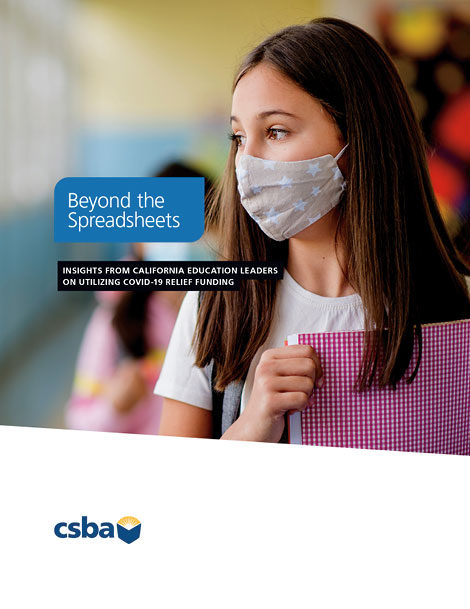
lush with one-time funds, local educational agencies have been tasked with charting a path to best use the billions of dollars in COVID relief funds they’ve received before each round of money sunsets.
So far, California school districts are indicating that they’re on track with spending, even with persisting challenges such as staffing shortages and burnout, supply chain issues, concerns about funding programs with one-time funds and navigating reporting requirements.
An added layer of pressure in the unprecedented situation is scrutiny from local and national media and members of the public looking to examine where every cent is going and publicize expenses perceived as unfit. While accountability is crucial and welcome, the notion that LEAs are holding onto every penny like Scrooge McDuck isn’t.
To offer a well-rounded view of relief spending that can be used as a resource by all interested parties (no central database currently exists), CSBA CEO and Executive Director Vernon M. Billy identified the need to conduct research on the topic to provide districts with information early on.
With all eyes on California public education, CSBA’s research team conducted a months-long analysis that is resulting in the release of a series of reports. The first, Unprecedented Times, Unprecedented Responses: An analysis of federal COVID-19 relief fund spending in California public schools, explores how more than 900 school districts and county offices of education from across the state are spending their federal COVID-19 relief funds — Elementary and Secondary School Relief (ESSER) I, II and IIII funds and the Governor’s Emergency Education Relief (GEER) I funds — to respond to pandemic-related challenges.
The second report report, Beyond the spreadsheets: Insights from California education leaders on utilizing COVID-19 relief funding, features findings from a CSBA survey of superintendents and school business officials on implementation strategies, challenges and their perspective on local needs and constraints, and is available at csba.org/COVID_Relief_Spending.
“These are documents that district leaders can reference to illustrate the utility of COVID relief funding and how dollars are being used across the state,” Billy said. “More importantly, this series shows the countless ways California’s governing boards have worked to quickly develop the strategies, programs and services needed to support students. Not all choices were or will be executed perfectly, but we can rest assured knowing boards are working tirelessly to create the best possible outcomes for their students and communities.”
According to CSBA’s findings, California LEAs are spending federal relief in accordance with associated deadlines. Statewide, on average, 94 percent of ESSER I and 87 percent of GEER I funds have been spent. Both have January 2023 deadlines. Fifty-seven percent of ESSER II, 17 percent of ESSER III (main) and 10 percent of ESSER III (academic impact of lost instructional time) have been used. ESSER II has a January 2024 deadline and ESSER III’s deadline is January 2025, though LEAs can apply to the U.S. Department of Education for an 18-month extension for ESSER III, primarily for construction projects.
In the wide-ranging survey of nearly 250 district leaders, primarily superintendents and school business officers, from LEAs of all sizes and locales, 91 percent said filling vacant or new positions present a moderate or very challenging barrier to using relief funds. Seventy percent of respondents had concerns about hiring staff they may not be able to keep when funding runs out and deemed it “very challenging” for implementation. These challenges with staffing are making it hard for LEAs to spend in other areas such as mental health supports and expanded learning opportunities (other topics covered in the survey).
Hardships aren’t stopping LEAs, however, on their quest to spend every last dime. As of March 2022, 89 percent of survey respondents indicated that they anticipate being able to spend funds by the current deadlines. By the time of this publication, LEAs have likely spent or made plans to spend more as they’ve finalized their 2022–23 budgets.



“You get yourself in trouble when you start relying on these one-time, temporary funds to plug holes in your ongoing expenses, so we’ve been separating out the one-time expenses and initiatives versus the ongoing expenses. We’ll see where we’re at in a year or two, in terms of what is working well, what do we keep, and what can we shift into the Local Control and Accountability Plan to sustain,” Whitaker said.
To identify spending priorities, the board conducted a collaborative evaluation and then directed district staff to develop a spending plan that incorporated their input. Every six months, an update is presented at a board meeting.
Some ways money has been spent include expanding summer school with enrichment programs and activity camps; significantly expanding mental health supports; providing WiFi hotspots; maintaining the virtual academy; funding the first phase of the HVAC replacement project at a high school; and launching a new music curriculum option with a Mariachi program.
A declining enrollment district, Woodland Joint USD serves a little more than 9,000 students across rural and urban populations.
Another focus has been on boosting literacy proficiency for K-3 students, which includes professional development among other strategies, such as bringing on paraprofessionals to support students in developing reading skills. Literacy plans were also drafted.
To deal with staffing shortages, Whitaker said they’re giving COVID-19 impact stipends of $6,000 over three years to staff and have taken additional measures such as providing more compensation for teachers who cover for other classes during their preparation periods and increasing substitute pay.
“With the first batch of funds it was just COVID response, but with the second and third rounds of the ESSER dollars and some of the money that the state has brought to us, really being able to think about not just response, but also what recovery and long-term resilience look like and how those factor into the decision making and prioritization in how you want to go about spending money to support students,” Whitaker said.
In one of the state’s top 10 largest districts, Orange County’s Capistrano USD, declining enrollment is also taking place, a trend that predates the pandemic. They currently serve more than 43,000 students, Superintendent Kirsten M. Vital Brulte said.
Capistrano USD, a basic aid district that does not receive concentration grants under the Local Control Funding Formula, has approached spending with a clear theory of action prioritizing literacy and numeracy.

With relief funding, “we have paid for Multi-Tiered System of Support specialists, we also paid for elementary PE teachers, and instructional paraprofessionals to be able to then have the kids with them doing PE twice a week so teachers, by grade level, can come together and have that slot of time,” Vital Brulte said. “If you’re asking teachers to do this work, you really need to be able to provide that time together in order to do it.”
Smaller class sizes, professional development time, after-school and summer programs have also been paid for using COVID-relief funds.
Knowing that in-person learning was a local priority, the district resumed on-campus learning in September 2020 using a phase-in plan.
In the 2022–23 academic year, Vital Brulte said the district is even more focused on social-emotional supports as “we know that the pandemic has really been hard on children and adults.” In addition to offering elementary counseling services, they’ve reduced caseloads for individual counselors at the middle and high school levels.
Both Woodland and Capistrano anticipate being able to utilize all relief funding by their respective deadlines.
During CSBA’s July 12 webinar on the federal relief report, Unprecedented Times, Unprecedented Responses, CSBA President-elect and Pacific Union Elementary School District trustee Susan Markarian expressed her district’s concern over a looming HVAC project, which also requires new roofs.
“Going forward we’re leery about the big projects we have planned because we’re not sure the money will be there when we’re ready,” Markarian said. “With small districts and not a very big budget, we don’t want to get into a position where we are short on cash because we’ve expended large amounts of money on a large project.”
At Pacific Union ESD, Markarian said they were able to bring on a full-time psychologist and a full-time nurse. “For a campus of only about 350 students that is almost unheard of — to have those kinds of services for students and their social, mental and physical health,” she said. “What we’re getting right now isn’t going to last, but it’s going to do some great things.”
WestEd has created multiple resources on the topic since the onset of the public health crisis.
In summer 2021, the nonpartisan, nonprofit research, development and service agency released a four-part series on how federal relief aid can be maximized to support more equitable student learning and providing strategies for using one-time federal funding on school staffing, investing one-time federal relief aid to make a lasting difference, and for getting federal relief aid to students who need it most. All four policy briefs can be found at bit.ly/3SCzM68.
More recently, in partnership with the California Department of Education, WestEd participated in three interactive online sessions covering how LEAs can use one-time funds in collaboration with long-term resources to fast-track equitable learning opportunities and supports. Pre-recorded sessions, coaching tools and takeaways to support maximizing investments for students, addressing staffing needs and achieving sustainability are available at https://bit.ly/3zEiL2V.
Recognizing that the categories and multiple timelines for using state and federal resources make it complex for districts to manage, Willis recommended documenting in one location all the funding available and then finding the right configuration of dollars to reach agreed-upon goals.
Overall, districts appear to be managing their budgets to meet deadlines effectively.
“In California’s context, those federal resources are really complemented by a vast amount of state resources as well,” Willis said. “I would really encourage districts to think about the combinations of those one-time funding sources across both federal and state levels as a means to understand how they can best optimize the one-time resources they have available and identify a longer tail of opportunity and see programs go for years.”
Teachers and staff “shouldn’t be undervalued as part of the solution to making the most of resources,” Willis said, adding that they’ve been through a lot in the past few years and have still gone to great lengths to serve K-12 students.
On the issue of staff shortages, Willis said he thinks “there is some degree of urgency that needs to be acted on to figure out how to bolster the pipeline of professionals who are coming into education staff positions.” Ideas for solutions may be found by talking to an LEA’s human resources personnel or local staff about their experiences.
In Capistrano USD, a financial transparency portal on the districts website displays information on regular spending as well as COVID relief funds. According to Vital Brulte, they’re also in the process of creating an infographic on COVID relief spending “to try and make this as user friendly as possible because we know how complex this is.”
In addition to videos from the superintendent, the CUSD Insider publication shares district news and other methods of communication — including text messaging and an app set to launch in fall — keep families in the loop with all happenings.
Vital Brulte added that allowing members of the public to participate in board meetings both in person and virtually has driven participation and feedback on topics.
During CSBA’s webinar, Chief Information Officer Troy Flint noted that, “during this time of unprecedented attention and scrutiny around how schools are running their operations and allocating the money, it’s important that you’re able to present an accurate picture of what you’re doing.”
Engaging with the community is also a good way to identify emerging needs and priorities.
To build public support around initiatives, LEAs should be proactive about sharing spending data and specific about expenditures — connecting those expenditures to LCAP or strategic plan goals when possible.
Education leaders can preview future strategies and goals for funding, talk honestly about challenges and successes, tell the district’s story on social media or engage with partners such as journalists to help disseminate information, and share a post-pandemic vision for local schools.
Heather Kemp is a staff writer for California Schools.